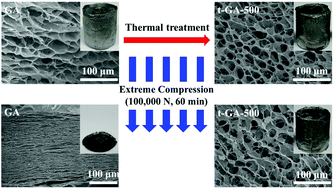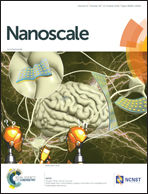Graphene aerogels that withstand extreme compressive stress and strain†
Abstract
Graphene aerogels combining elastic, lightweight, and robust mechanical properties have been explored for a wide variety of applications. However, graphene aerogels are generally subject to brittle mechanical properties and the irreversible damage of network structures during extreme compressions. Thus, the challenge of finding ways to enhance the strength and resilience of graphene aerogels remains. Herein, superelastic and ultralight aerogels are fabricated through a thermal-treatment of 3D ordered graphene aerogels. The treatments at 400–1000 °C eliminate most of the oxygen-containing functional groups and enhance the π–π stacking interactions between graphene sheets, forming a well-ordered structure of graphene sheets in cell walls. The aerogels can withstand a loading of 100 000 N (109 times their own weight) for 60 min and retain their substantial elastic resilience. This loading corresponds to an ultimate compressive stress of approximately 1000 MPa and a strain of 99.8%, and this ultimate stress is 1–2 orders of magnitude higher than the values for other (carbon-based, polymer-based, inorganic-based, and metal-based) porous materials. The superelastic properties can be attributed to the graphite-like ordered structure of cell walls. The successful fabrication of such superelastic materials opens a new avenue to explore their potential applications in pressure sensors, mechanical shock absorbers, soft robots, and deformable electronic devices.

- This article is part of the themed collection: Graphene Turns 15: Bio-implications and Bio-applications


 Please wait while we load your content...
Please wait while we load your content...